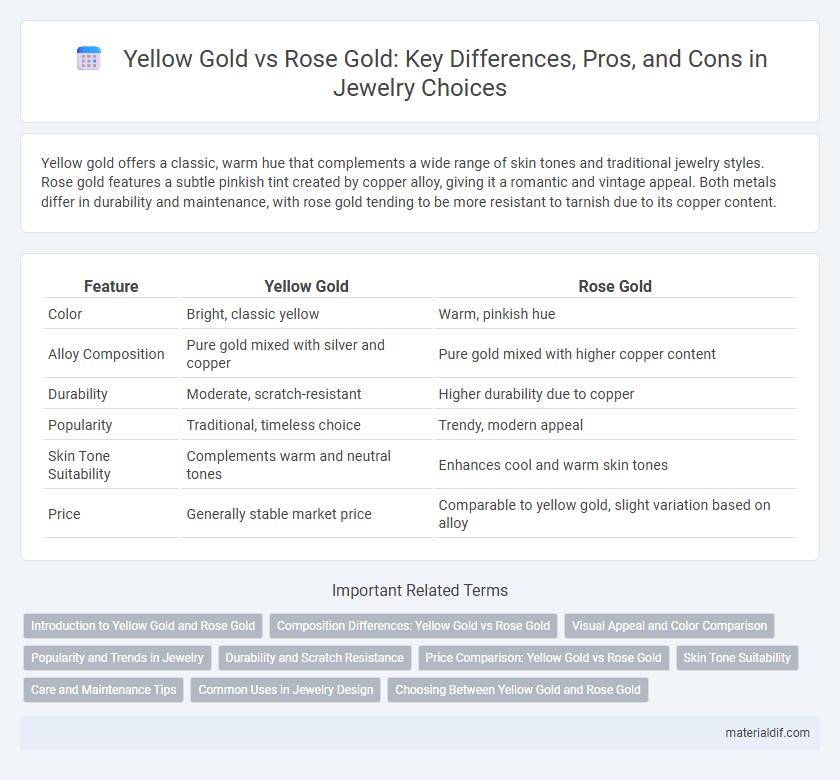Yellow gold offers a classic, warm hue that complements a wide range of skin tones and traditional jewelry styles. Rose gold features a subtle pinkish tint created by copper alloy, giving it a romantic and vintage appeal. Both metals differ in durability and maintenance, with rose gold tending to be more resistant to tarnish due to its copper content.
Table of Comparison
| Feature | Yellow Gold | Rose Gold |
|---|---|---|
| Color | Bright, classic yellow | Warm, pinkish hue |
| Alloy Composition | Pure gold mixed with silver and copper | Pure gold mixed with higher copper content |
| Durability | Moderate, scratch-resistant | Higher durability due to copper |
| Popularity | Traditional, timeless choice | Trendy, modern appeal |
| Skin Tone Suitability | Complements warm and neutral tones | Enhances cool and warm skin tones |
| Price | Generally stable market price | Comparable to yellow gold, slight variation based on alloy |
Introduction to Yellow Gold and Rose Gold
Yellow gold, a classic alloy composed primarily of pure gold mixed with metals like copper and zinc, boasts a rich, warm hue that has symbolized wealth and tradition for centuries. Rose gold, created by combining pure gold with a higher proportion of copper, offers a distinctive pinkish-red tint that enhances its romantic and vintage appeal. Both types of gold maintain durability and malleability, making them popular choices for jewelry that balances aesthetic elegance with lasting strength.
Composition Differences: Yellow Gold vs Rose Gold
Yellow gold is typically composed of pure gold alloyed with metals like copper and silver, which maintain its classic warm, golden hue. Rose gold contains a higher percentage of copper, giving it a distinct reddish-pink tint that intensifies with increased copper content. The specific alloy ratios directly affect the color, durability, and hypoallergenic properties of each type of gold.
Visual Appeal and Color Comparison
Yellow gold boasts a rich, classic hue with warm, buttery tones that complement a wide range of skin tones, enhancing timeless elegance. Rose gold features a distinctive pinkish-red tint created by adding copper, offering a romantic and vintage-inspired look that stands out for its subtle warmth and softness. The visual appeal of yellow gold tends toward traditional luxury, whereas rose gold provides a modern twist with a unique and eye-catching color contrast.
Popularity and Trends in Jewelry
Yellow gold remains a timeless favorite in jewelry due to its classic, warm hue and strong cultural associations with luxury and tradition. Rose gold has surged in popularity, especially among younger consumers and in modern designs, thanks to its romantic pinkish tint and versatility across various skin tones. Current trends highlight rose gold's dominance in engagement rings and fashion accessories, while yellow gold maintains steady demand in heritage and high-end pieces.
Durability and Scratch Resistance
Yellow gold, traditionally composed of pure gold alloyed with metals like copper and zinc, exhibits moderate durability and scratch resistance suitable for everyday wear. Rose gold contains a higher copper content, enhancing its hardness and making it more resistant to scratches and dents compared to yellow gold. Both alloys maintain excellent corrosion resistance, but rose gold's denser composition offers improved longevity under frequent use.
Price Comparison: Yellow Gold vs Rose Gold
Yellow gold typically commands a higher price than rose gold due to its higher purity levels, often ranging from 18K to 24K, which increases its gold content and value. Rose gold, an alloy mixed with copper and sometimes silver, tends to be more affordable because copper lowers the overall gold concentration. Market demand and rarity also influence pricing, with yellow gold maintaining a consistent premium in global jewelry markets.
Skin Tone Suitability
Yellow gold complements warm skin tones by enhancing natural golden undertones and providing a classic, rich appearance. Rose gold flatters cooler skin tones, offering a subtle pink hue that brightens and adds warmth without overpowering the complexion. Selecting between yellow and rose gold depends on matching the jewelry's undertone with skin undertones for the most harmonious and flattering look.
Care and Maintenance Tips
Yellow gold requires regular gentle cleaning with mild soap and warm water to maintain its classic shine and prevent tarnish. Rose gold, enriched with copper, is more resistant to scratches but benefits from avoiding harsh chemicals that can dull its warm hue. Both metals should be stored separately in soft cloth pouches to minimize abrasion and preserve their luster over time.
Common Uses in Jewelry Design
Yellow gold is frequently used in classic and traditional jewelry designs such as wedding bands, vintage-inspired pieces, and heirloom-quality necklaces due to its warm, rich color and timeless appeal. Rose gold, prized for its romantic pinkish hue, is popular in contemporary and fashion-forward jewelry, including engagement rings, bracelets, and stacks of layered rings. Both metals offer versatility but rose gold often enhances feminine and modern aesthetics, while yellow gold remains favored for elegant, formal, and antique-style creations.
Choosing Between Yellow Gold and Rose Gold
Choosing between yellow gold and rose gold depends on personal style preferences and skin tone compatibility; yellow gold complements warm skin tones with its classic, rich hue, while rose gold offers a romantic, vintage appeal that suits cooler or neutral complexions. Durability differences are minimal, but rose gold often contains copper, enhancing its strength and resistance to tarnish compared to traditional yellow gold alloys. Consider the jewelry's intended use and matching accessories, as yellow gold pairs well with traditional designs, whereas rose gold is favored for contemporary and unique pieces.
Yellow gold vs Rose gold Infographic

 materialdif.com
materialdif.com